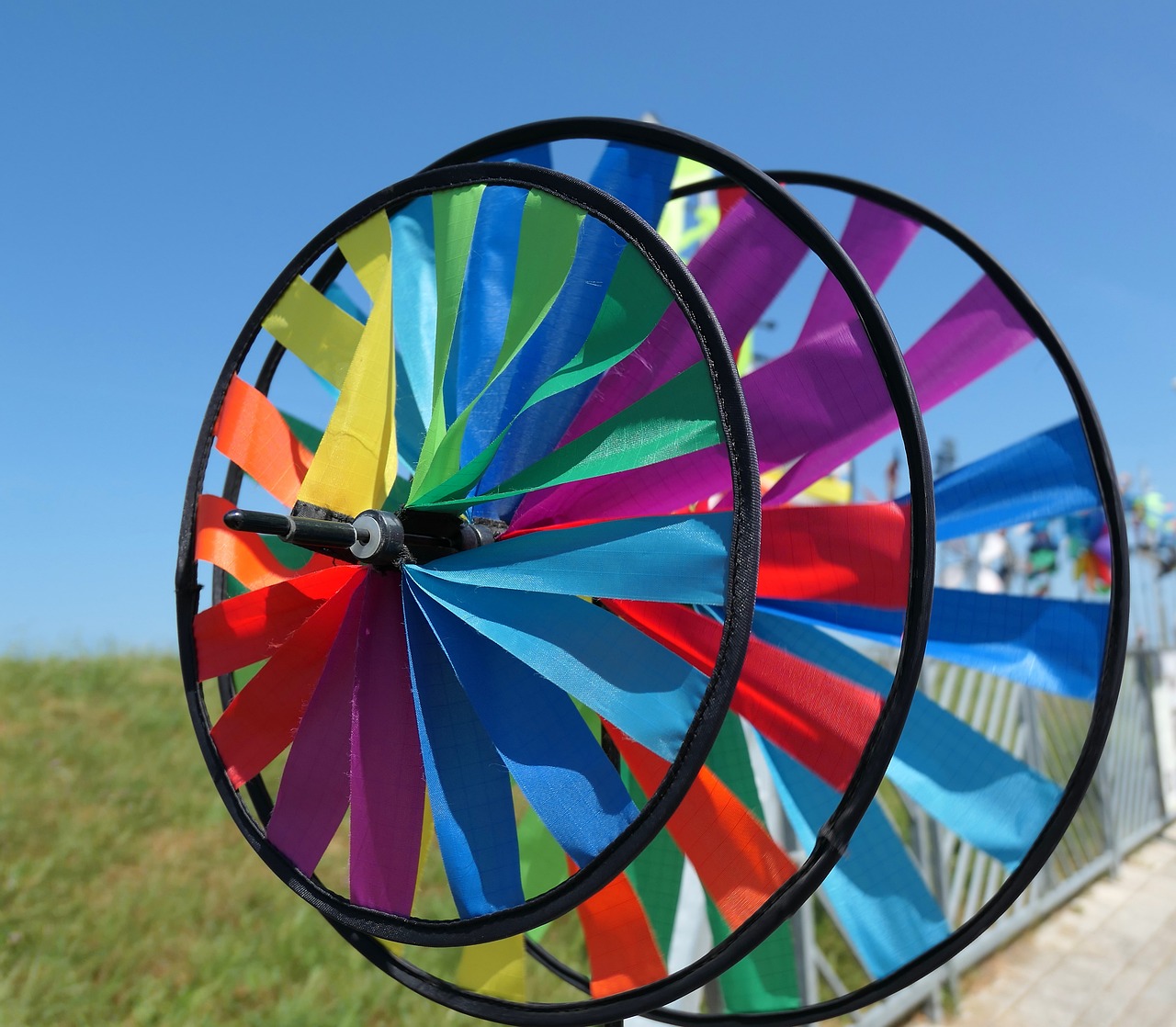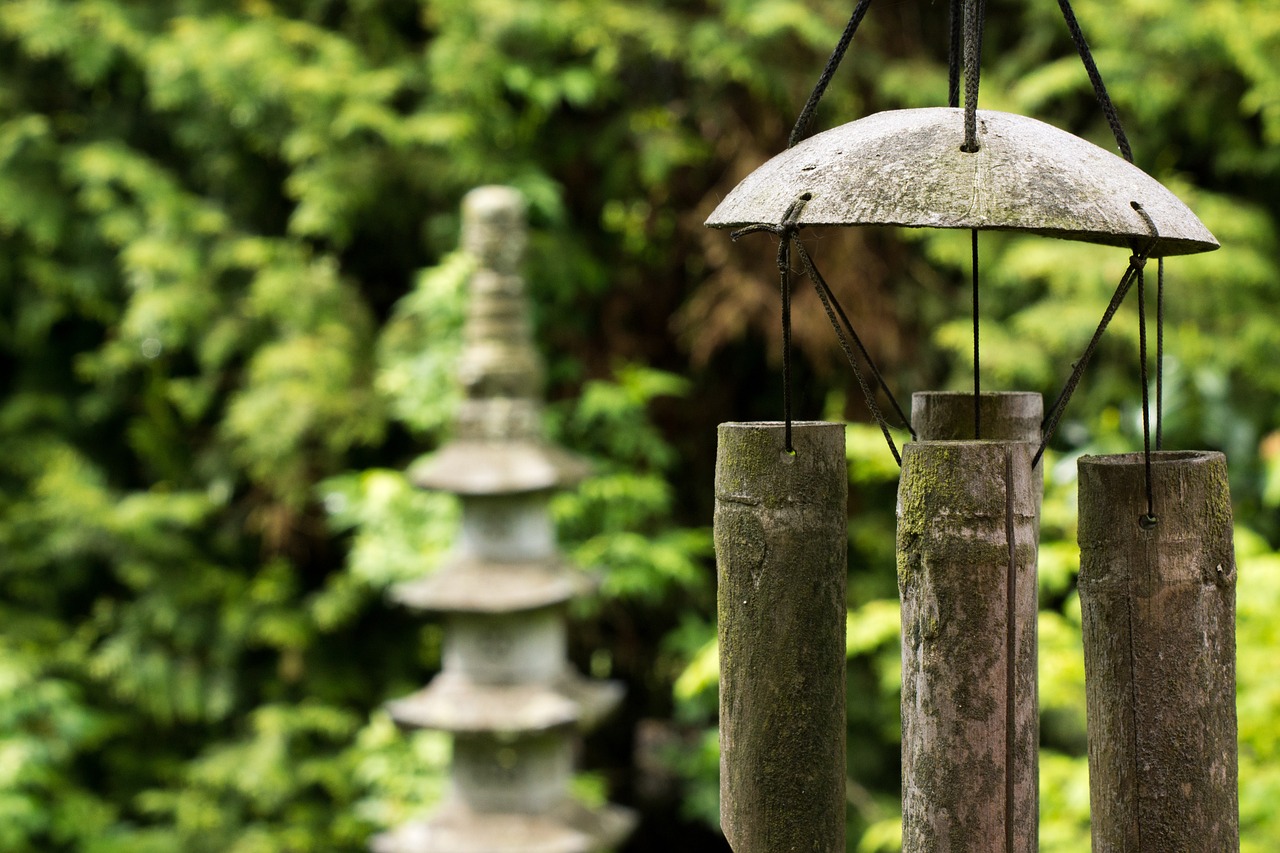Make Your Own DIY Wind Chimes for Your Balcony
Are you ready to transform your balcony into a serene oasis filled with the beautiful sounds of nature? Crafting your own DIY wind chimes is not just a fun project; it's a way to add a personal touch to your outdoor space. Imagine sitting on your balcony, sipping your favorite drink, and listening to the gentle tinkling of your handmade wind chimes as they sway in the breeze. Sounds delightful, right? In this article, we'll dive into the creative process of making wind chimes, from choosing the right materials to assembly tips, ensuring that you have everything you need to create a stunning auditory masterpiece that reflects your unique style.
When it comes to making wind chimes, selecting the appropriate materials is crucial. The materials you choose will not only determine the durability of your chimes but also the quality of sound they produce. Think of it like cooking; the ingredients make all the difference! Here are some popular options:
- Wood: Offers a warm, earthy tone and is easy to work with.
- Metal: Produces a clear, resonant sound and can withstand the elements.
- Glass: Adds a beautiful visual element and creates a delicate chime.
By mixing and matching these materials, you can create a wind chime that is not only beautiful but also uniquely yours. Don’t hesitate to experiment with different combinations to find the perfect fit for your design.
Now that you've got your materials sorted, it's time to unleash your creativity! The design of your wind chimes can range from rustic to modern, depending on your personal taste. Here are a few inspiring ideas to get your creative juices flowing:
- Rustic Charm: Use reclaimed wood and natural twine for a cozy, farmhouse feel.
- Modern Minimalism: Opt for sleek metal rods and a simple color palette for a chic look.
- Bohemian Vibes: Incorporate colorful beads, shells, and feathers for a whimsical touch.
Remember, your wind chimes should tell a story—your story. So, let your imagination run wild and create something that resonates with who you are!
Incorporating natural elements like shells, stones, or bamboo can add an organic touch to your wind chimes. Just picture it: the gentle sound of bamboo clinking together, reminiscent of a tranquil forest. Not only do these materials enhance the visual appeal, but they also contribute to the overall sound quality. For instance, shells can create a soft, soothing sound, while stones can produce a deeper, more resonant tone. The beauty of using natural elements is that they connect your wind chimes to the environment, making them feel like a part of nature itself.
One of the best parts of making your own wind chimes is the ability to recycle old items. Not only does this save you money, but it also promotes sustainability. Think about items you have around the house that could be repurposed:
- Old silverware can be transformed into charming chimes.
- Glass bottles can be cut and shaped into beautiful pieces.
- Even old keys or toys can add a unique flair!
By giving new life to everyday objects, your wind chimes not only become a conversation starter but also a testament to your creativity and eco-consciousness.
Choosing a cohesive color scheme can elevate the overall look of your wind chimes. Consider how the colors will complement your balcony decor. For a harmonious atmosphere, think about using colors that evoke certain feelings. For example:
| Color | Emotion |
|---|---|
| Blue | Calmness |
| Green | Nature and Growth |
| Red | Energy and Passion |
By carefully selecting your color palette, you can create a visual masterpiece that enhances the overall ambiance of your outdoor space.
The sound produced by wind chimes is essential for their charm. It’s like the icing on the cake! To achieve the desired pitch and resonance, you might want to experiment with the length and thickness of the materials you’re using. Longer pieces tend to produce deeper tones, while shorter pieces create higher pitches. You can even tune your chimes by adjusting the placement of the weights or adding small objects to enhance the sound. It’s all about finding that perfect harmony that brings you joy every time the wind blows.
Assembling your wind chimes can be a fun and rewarding experience. Follow these simple steps to ensure a sturdy and well-balanced final product:
- Cut your materials to the desired lengths.
- Drill holes in the appropriate places for hanging.
- Attach your pieces using strong twine or fishing line.
- Hang a weight at the bottom to ensure they catch the wind.
With a little patience and creativity, you’ll have a beautiful wind chime that dances in the breeze!
Properly hanging your wind chimes is vital for optimal sound and visibility. Consider various hanging techniques, such as:
- Using a sturdy branch or hook on your balcony.
- Creating a decorative display using multiple chimes at different heights.
- Incorporating your chimes into a plant arrangement for a natural look.
Whatever you choose, make sure your wind chimes are positioned where they can catch the wind and be admired by all.
To keep your wind chimes looking and sounding their best, regular maintenance is key. Here are a few simple care tips:
- Clean your chimes periodically to remove dirt and debris.
- Check for any damage after storms or high winds.
- Store them indoors during harsh weather conditions.
By taking these steps, you’ll ensure that your handcrafted chimes continue to bring joy for years to come.
Q: What materials are best for beginners?
A: Start with wood and metal, as they are easy to manipulate and produce lovely sounds.
Q: How do I tune my wind chimes?
A: Adjust the lengths of the rods or add weights to achieve the desired pitch.
Q: Can I use plastic materials?
A: Yes, but be mindful that they may not produce as rich a sound as wood or metal.
Q: How do I prevent my wind chimes from rusting?
A: Use materials that are rust-resistant, such as stainless steel or coated metals.

Choosing the Right Materials
This article explores the creative process of crafting your own wind chimes, offering tips, materials, and inspiration to enhance your balcony's ambiance with beautiful, melodic sounds.
When it comes to crafting your own wind chimes, is paramount. The materials you select will not only affect the durability of your chimes but also their sound quality and overall aesthetic. Imagine the soft tinkling of metal against wood or the gentle clinking of glass in the breeze—each material brings its own unique character to the table. So, what should you consider when making your choice?
First, think about the sound. Different materials produce different tones. For example, metal chimes tend to create a sharper, more resonant sound, while wooden chimes offer a warmer, more mellow tone. If you’re aiming for a soothing atmosphere, you might lean towards wood or bamboo. On the other hand, if you want something that really sings in the wind, metal could be your best bet.
Here’s a quick breakdown of some popular materials:
| Material | Sound Quality | Aesthetic Appeal |
|---|---|---|
| Wood | Mellow, warm tones | Natural and rustic |
| Metal | Bright, resonant sounds | Modern and sleek |
| Glass | Delicate, tinkling sounds | Artistic and colorful |
| Bamboo | Soft, earthy tones | Organic and eco-friendly |
Next, consider the visual appeal. You want your wind chimes to not only sound beautiful but also look stunning hanging on your balcony. Think about the color and texture of your materials. For instance, if you have a modern balcony, shiny metal or colorful glass could enhance that vibe. If your space is more rustic, wooden or bamboo chimes might fit perfectly.
Don’t forget about weight and balance. Heavier materials may require sturdier hanging mechanisms, while lighter materials can sway more freely in the wind. Consider how these factors will influence the overall performance of your chimes. You want them to be able to catch the wind without being too cumbersome.
Finally, think about incorporating recycled materials. Not only is this a sustainable option, but it also allows for a unique and personal touch. Old silverware, bottle caps, or even discarded jewelry can be transformed into stunning wind chimes that tell a story. It’s a great way to add character and charm to your creation.
In summary, when choosing materials for your wind chimes, consider their sound quality, aesthetic appeal, weight, and the potential for recycling. Each choice you make will contribute to the overall beauty and functionality of your chimes, making your balcony a delightful retreat filled with music and charm.
- What is the best material for wind chimes? It depends on the sound you want! Metal produces bright sounds, while wood offers mellow tones.
- Can I use recycled materials? Absolutely! Recycled materials can add a unique touch and are environmentally friendly.
- How do I ensure my wind chimes are balanced? Make sure to distribute the weight evenly and test the balance before hanging them.

Design Ideas for Your Wind Chimes
When it comes to crafting your own wind chimes, the design possibilities are endless. Whether you're aiming for a rustic charm or a sleek modern aesthetic, the beauty of DIY wind chimes lies in their ability to reflect your personality and style. Imagine stepping onto your balcony and being greeted by the gentle, melodic sounds of your unique creation swaying in the breeze. How can you bring that vision to life? Let's dive into some exciting design ideas that will inspire your next project!
First off, think about the overall theme you want to convey. Are you drawn to nature? Consider incorporating elements like driftwood, shells, or bamboo. These materials not only add an organic touch but also produce soothing sounds when the wind dances through them. For a beach-themed chime, you could use a combination of seashells and small pieces of driftwood, creating a serene coastal vibe right on your balcony.
If modern aesthetics are more your style, consider using materials like metal and glass. Metal pipes can create a bright, resonant sound, while glass beads can add a touch of color and sparkle. Picture a sleek design with shiny aluminum tubes hanging at different lengths, catching the sunlight and creating a stunning visual display. You might even want to experiment with color gradients in your glass elements to create a cohesive look that ties in with your balcony decor.
Another fun idea is to use recycled materials. Not only does this promote sustainability, but it also allows you to tell a unique story through your wind chimes. Old silverware, for example, can be transformed into whimsical chimes that evoke a sense of nostalgia. Think of the clinking sounds of forks and spoons gently swaying in the breeze, bringing a delightful auditory experience to your space.
Don't forget about the importance of color schemes. Choosing a cohesive color palette can elevate the overall look of your wind chimes. For instance, if your balcony features earthy tones, you might select natural wood and muted colors for your chimes. Conversely, if your space is vibrant and colorful, you could opt for bright, bold hues that stand out and create a lively atmosphere. The key is to ensure that your wind chimes complement the existing decor and enhance the ambiance of your outdoor space.
As you brainstorm design ideas, remember that the sound quality of your wind chimes is just as important as their appearance. The materials you choose will greatly influence the pitch and resonance of the chimes. For example, thicker metal pipes will produce deeper tones, while thinner ones will create higher pitches. Experimenting with different lengths and thicknesses can help you achieve the perfect sound that resonates with your personal taste.
Ultimately, the design of your wind chimes should be a reflection of who you are. Whether you prefer a simple and elegant look or something more eclectic and colorful, the creative process of crafting these beautiful pieces will bring joy and satisfaction. So grab your materials, unleash your creativity, and let the gentle sounds of your DIY wind chimes transform your balcony into a serene oasis.
- What materials are best for wind chimes? The best materials depend on the sound you want. Metal produces bright tones, while wood offers a softer sound. Glass adds visual appeal.
- How do I tune my wind chimes? You can tune your chimes by adjusting the length of the hanging pieces. Shorter pieces produce higher pitches, while longer ones create lower tones.
- Can I use recycled materials? Absolutely! Recycled materials can add character and uniqueness to your wind chimes.

Natural Elements in Wind Chimes
Incorporating natural elements into your DIY wind chimes not only enhances their aesthetic appeal but also enriches the auditory experience they provide. Imagine the gentle sound of shells clinking together or the soft rustle of bamboo in the breeze. These elements can transform your wind chimes into a harmonious blend of nature and art, creating a delightful ambiance on your balcony.
When considering natural materials, think about how they resonate and interact with the wind. For instance, seashells can produce a soothing sound reminiscent of ocean waves, while stones can add a grounding, earthy tone. Bamboo, known for its flexibility and durability, offers a warm, mellow sound that many find enchanting. You might even want to mix and match these elements to create a unique soundscape that resonates with your personal style.
Here are some natural materials you might consider for your wind chimes:
- Seashells: Perfect for a beachy vibe and they create soft, melodic tones.
- Bamboo: Lightweight and resonant, bamboo chimes are often used in traditional designs.
- Stones: Use smooth, rounded stones for a heavier sound that adds a rustic feel.
- Wood: Different types of wood can produce varying tones, so choose wisely!
Moreover, the visual aspect of these natural materials adds a layer of beauty to your chimes. Imagine a stunning arrangement of colorful shells or a rustic look with weathered wood. Each piece tells a story, making your wind chimes not just musical instruments but also captivating decor. By thoughtfully selecting and combining these elements, you can create a stunning centerpiece for your balcony that reflects your unique personality and style.
As you embark on your crafting journey, remember that the key to a successful wind chime lies in the balance between sound and beauty. The natural materials you choose will play a pivotal role in achieving that perfect harmony. So, let your creativity flow as you explore the endless possibilities that nature has to offer!
Q: What materials are best for making wind chimes?
A: The best materials depend on the sound you want to achieve. Common choices include wood, metal, glass, and natural elements like shells and stones.
Q: How do I ensure my wind chimes are durable?
A: Choose weather-resistant materials and ensure all connections are secure. Regular maintenance can also help prolong their life.
Q: Can I use recycled materials for my wind chimes?
A: Absolutely! Using recycled materials not only saves money but also adds a unique touch to your chimes. Just ensure they are safe and sturdy enough to withstand outdoor conditions.
Q: How do I hang my wind chimes for the best sound?
A: Hang them in an open area where they can catch the wind. Ensure they are not too close to walls or other obstacles that might muffle the sound.

Using Recycled Materials
Using recycled materials to create your own wind chimes is not only a fantastic way to save money, but it also allows you to express your creativity while being environmentally friendly. Imagine transforming everyday items that would typically end up in the trash into beautiful, melodic pieces that enhance your balcony's ambiance. This approach not only gives your wind chimes a unique character but also tells a story of sustainability and innovation.
To get started, look around your home for items that you no longer use or need. Old keys, broken jewelry, or even discarded kitchen utensils can be repurposed into stunning wind chime components. For instance, a collection of mismatched spoons can create a charming, rustic vibe, while colorful bottle caps can add a playful touch. The beauty of using recycled materials is that each piece will have its own history, making your wind chimes one-of-a-kind.
Here are some materials you might consider:
- Glass Bottles: Cut them into different lengths to create chimes that produce varying tones.
- Wood Scraps: Use leftover wood from other projects to craft the frame or add to the chime’s body.
- Old CDs: Their reflective surface can catch the light beautifully while producing a unique sound.
- Shells and Driftwood: Perfect for a beachy vibe, these natural materials can be collected during a walk along the shore.
When using recycled materials, it’s essential to consider their durability and sound quality. Some materials might not withstand the elements as well as others. For example, while glass can create lovely sounds, it may shatter if not properly secured. Similarly, metal objects may rust over time, so choosing items that can endure outdoor conditions is crucial. By combining various materials, you can create a balanced and harmonious sound that resonates beautifully in the breeze.
Lastly, don’t forget to personalize your wind chimes with paint or decorative elements. A splash of color can make your recycled wind chimes pop, adding an artistic flair to your balcony. Whether you choose to keep the natural look of your materials or embellish them with vibrant hues, the final product will be a true reflection of your style and commitment to sustainability.
Q: What types of recycled materials work best for wind chimes?
A: The best materials include glass bottles, old utensils, keys, and natural items like shells or driftwood. Just ensure they can withstand outdoor conditions.
Q: How do I ensure my wind chimes produce a pleasant sound?
A: Experiment with different materials and lengths. Tuning them by adjusting the length of the hanging pieces can help you achieve the desired pitch.
Q: Can I paint my recycled materials?
A: Absolutely! Using outdoor paint can add a personal touch and protect the materials from the elements.
Q: How do I hang my wind chimes securely?
A: Use sturdy hooks or brackets and ensure they are well-balanced to prevent them from tipping over in the wind.

Color Schemes and Aesthetics
When it comes to creating your own DIY wind chimes, color schemes play a pivotal role in enhancing their visual appeal. Just like a painter chooses a palette, you too should consider how colors can evoke emotions and complement your balcony's ambiance. Imagine stepping onto your balcony and being greeted by a symphony of colors that harmonize with the natural surroundings. Whether you prefer a vibrant display or a more subdued look, the right combination can transform your wind chimes into a stunning focal point.
To get started, think about the overall theme of your balcony. Are you aiming for a rustic charm with earthy tones, or perhaps a modern vibe with sleek metallic finishes? Here are a few ideas to inspire your color choices:
- Earthy Tones: Shades of brown, green, and beige can create a natural, serene atmosphere.
- Bright Colors: Bold hues like red, blue, and yellow can add a playful touch and draw attention.
- Monochromatic Schemes: Using varying shades of a single color can create a sophisticated and cohesive look.
Furthermore, consider incorporating contrasting colors to make your wind chimes stand out. For instance, if your balcony features a lot of greenery, a splash of bright orange or yellow can create a striking contrast that catches the eye. On the other hand, if you want a more harmonious look, choose colors that are adjacent on the color wheel, like blue and green.
Don't forget about the materials you’re using! The finish of wood, metal, or glass can significantly affect how colors appear. For example, a shiny metallic finish will reflect light differently than a matte paint, altering the overall aesthetic. When selecting your materials, keep in mind how they will interact with the colors you choose.
Finally, think about how the colors of your wind chimes will look against the backdrop of your balcony decor. If your balcony is adorned with vibrant flowers, opt for colors that will either complement or contrast beautifully with them. This way, your wind chimes won't just be a standalone piece; they will be a part of a larger, cohesive design that enhances the entire space.
In summary, the color scheme and aesthetics of your DIY wind chimes can greatly influence their impact on your balcony. By carefully selecting colors that reflect your personal style and harmonize with your surroundings, you can create a delightful ambiance that resonates with beauty and creativity.
1. What materials are best for colorful wind chimes?
Using a mix of wood, glass, and metal can help achieve a vibrant look. Glass beads or painted wooden pieces can add pops of color.
2. How can I ensure my wind chimes match my balcony decor?
Consider the existing color scheme of your balcony. Choose colors that either complement or contrast with your furniture and plants.
3. Can I paint my wind chimes?
Absolutely! Painting your wind chimes can personalize them and allow you to experiment with different color schemes.
4. How often should I maintain the color of my wind chimes?
Regular maintenance is key, especially if they are exposed to the elements. Check for fading or peeling paint and touch up as necessary.

Sound Quality and Tuning
This article explores the creative process of crafting your own wind chimes, offering tips, materials, and inspiration to enhance your balcony's ambiance with beautiful, melodic sounds.
Selecting the appropriate materials is crucial for creating durable and resonant wind chimes. Explore various options, including wood, metal, and glass, to find the perfect combination for your design.
Get inspired with a variety of design ideas that cater to different aesthetics. From rustic to modern styles, discover how to personalize your wind chimes to reflect your unique taste.
Incorporating natural elements like shells, stones, or bamboo can add an organic touch to your wind chimes. Learn how these materials can enhance both the visual appeal and sound quality.
Recycling old items not only saves money but also promotes sustainability. Discover creative ways to transform everyday objects into beautiful wind chimes that tell a story.
Choosing a cohesive color scheme can elevate the overall look of your wind chimes. Explore color combinations that complement your balcony decor and create a harmonious atmosphere.
The sound produced by your wind chimes is not just a pleasant addition to your outdoor space; it’s the very essence that brings your creation to life. The right pitch and resonance can transform a simple wind chime into a melodious instrument that dances with the breeze. To achieve this, understanding how to tune your wind chimes is essential. Consider the following factors:
- Material Choice: Different materials produce distinct sounds. For example, metal chimes often create a bright, clear tone, while wooden chimes emit a warmer, softer sound.
- Length of the Chimes: The length of each chime affects the pitch. Longer chimes produce lower notes, while shorter ones create higher pitches. Experimenting with various lengths can help you find the perfect harmony.
- Weight and Thickness: Heavier and thicker chimes tend to produce deeper sounds, whereas lighter and thinner materials yield higher tones. Balancing these elements is key to achieving your desired sound.
To fine-tune your chimes, you can even use a tuner app or a musical instrument to help you match the pitches accurately. As you adjust the lengths or weights of your chimes, don’t forget to listen carefully. Sometimes, the most beautiful sounds come from unexpected combinations!
Moreover, consider creating a sound chart for your wind chimes. This chart can include the lengths, materials, and corresponding notes for each chime, allowing you to replicate your favorite designs in the future. Here’s a simple example of what that might look like:
| Chime Material | Length (inches) | Pitch |
|---|---|---|
| Aluminum | 12 | C4 |
| Bamboo | 10 | E4 |
| Glass | 8 | G4 |
By paying attention to these details, you’ll not only create stunning wind chimes but also ensure they sound as delightful as they look. So, grab your materials, let your creativity flow, and tune your chimes to perfection!
Assembling your wind chimes can be a fun and rewarding experience. Follow step-by-step instructions to ensure a sturdy and well-balanced final product that will withstand outdoor elements.
Properly hanging your wind chimes is vital for optimal sound and visibility. Explore various hanging techniques and display options to showcase your creations beautifully on your balcony.
To keep your wind chimes looking and sounding their best, regular maintenance is key. Discover simple care tips to ensure longevity and continued enjoyment of your handcrafted chimes.
Q: How do I choose the best materials for my wind chimes?
A: Consider the sound you want to achieve. Metal for clarity, wood for warmth, and glass for a unique touch. Mix and match for a personalized sound!
Q: Can I use recycled materials?
A: Absolutely! Recycled materials can add character and sustainability to your wind chimes. Get creative with items like old cutlery or bottles!
Q: How can I ensure my wind chimes last?
A: Regular maintenance, such as cleaning and checking for wear, will help your wind chimes withstand the elements and keep their beautiful sound.

Assembly and Construction Tips
Assembling your own DIY wind chimes can be one of the most rewarding parts of the entire crafting process. It’s where all your creative ideas come together, and you can see your vision take shape. To get started, gather all your materials and tools in one place. This will not only save you time but also make the assembly process much smoother. A good workspace is essential; consider working on a flat, stable surface where you can easily reach everything you need.
When it comes to assembling your wind chimes, patience is key. Take your time to ensure that each component is securely attached. Start with the main structure, which is typically the top piece where the chimes will hang from. Whether you’re using a wooden dowel, a metal ring, or even a repurposed item like an old plate, make sure it’s sturdy enough to support the weight of your chimes.
Next, it’s time to focus on the chimes themselves. Depending on the materials you’ve chosen, you might need to drill holes for the strings or wires. If you’re using glass or metal, a diamond-tipped drill bit will work wonders. For wooden chimes, pre-drilling holes can help prevent the wood from splitting. Ensure that the holes are evenly spaced to maintain balance, which is crucial for achieving that lovely sound when the wind blows.
Once you’ve prepared your chimes, it’s time to cut your strings or wires. A good rule of thumb is to make them about three times the length of the chime pieces, allowing enough slack for movement. When attaching the chimes, consider using a double knot for added security. This will prevent them from slipping or falling off. For a more polished look, you can use beads or decorative elements to hide the knots.
After assembling the chimes, it’s crucial to balance them properly. Hang the chimes from the top piece and adjust their positions until they are evenly spaced. You can test the sound by gently tapping each chime; they should produce a harmonious tone. If they’re too close together, they might clash and create a jarring sound. Remember, the goal is to create a soothing melody that dances with the wind!
Finally, don’t forget to consider the hanging mechanism. Whether you choose to use a hook, a loop, or a simple knot, ensure it’s secure enough to withstand outdoor elements. If you live in a windy area, you might want to reinforce the hanging point with additional support. Here’s a quick overview of the assembly process:
| Step | Description |
|---|---|
| 1 | Gather materials and tools in a clean workspace. |
| 2 | Prepare the main structure (top piece). |
| 3 | Drill holes for strings or wires. |
| 4 | Cut strings/wires to appropriate lengths. |
| 5 | Attach chimes securely with double knots. |
| 6 | Balance the chimes for harmonious sound. |
| 7 | Secure the hanging mechanism. |
With these assembly and construction tips, you’ll be well on your way to creating beautiful wind chimes that will enhance your balcony’s ambiance. Remember, the process should be enjoyable, so let your creativity flow and don’t be afraid to experiment!
Q: What materials are best for wind chimes?
A: The best materials depend on the sound you desire. Metal produces a bright tone, while bamboo offers a softer sound. Glass can add a beautiful visual element but may require extra care.
Q: How do I ensure my wind chimes are weather-resistant?
A: To make your wind chimes weather-resistant, use waterproof sealants on wooden parts and rust-resistant materials for metal components. Regular maintenance will also help prolong their lifespan.
Q: Can I use recycled materials?
A: Absolutely! Using recycled materials not only saves money but also adds a unique touch to your wind chimes. Be creative and think outside the box!
Q: How can I enhance the sound quality?
A: To enhance sound quality, ensure your chimes are balanced and spaced correctly. Experiment with different lengths of chimes to achieve a harmonious melody.

Hanging and Display Options
This article explores the creative process of crafting your own wind chimes, offering tips, materials, and inspiration to enhance your balcony's ambiance with beautiful, melodic sounds.
Selecting the appropriate materials is crucial for creating durable and resonant wind chimes. Explore various options, including wood, metal, and glass, to find the perfect combination for your design.
Get inspired with a variety of design ideas that cater to different aesthetics. From rustic to modern styles, discover how to personalize your wind chimes to reflect your unique taste.
Incorporating natural elements like shells, stones, or bamboo can add an organic touch to your wind chimes. Learn how these materials can enhance both the visual appeal and sound quality.
Recycling old items not only saves money but also promotes sustainability. Discover creative ways to transform everyday objects into beautiful wind chimes that tell a story.
Choosing a cohesive color scheme can elevate the overall look of your wind chimes. Explore color combinations that complement your balcony decor and create a harmonious atmosphere.
The sound produced by wind chimes is essential for their charm. Learn techniques for tuning your chimes to achieve the desired pitch and resonance for a delightful auditory experience.
Assembling your wind chimes can be a fun and rewarding experience. Follow step-by-step instructions to ensure a sturdy and well-balanced final product that will withstand outdoor elements.
Once you’ve crafted your stunning wind chimes, the next step is figuring out how to hang and display them effectively. Choosing the right location is crucial, as it can greatly influence both the sound and visibility of your chimes. Ideally, you want to find a spot that catches the wind but is also safe from harsh weather conditions. A sheltered balcony corner or a spot near an open window can be perfect.
Consider using a sturdy hook or a decorative bracket to hang your wind chimes. Not only does this ensure they stay secure, but it also adds an aesthetic touch. If you want your wind chimes to sway gracefully, you might want to use a swivel hook that allows them to rotate with the wind. This can create a mesmerizing visual effect, especially when combined with colorful materials.
Another option is to create a multi-tiered display. You can hang several chimes of varying lengths and materials at different heights. This not only enhances the visual appeal but also creates a richer sound as the chimes will resonate at different pitches. Here’s a quick overview of some popular hanging methods:
| Hanging Method | Description |
|---|---|
| Swivel Hooks | Allows chimes to rotate, enhancing movement and sound. |
| Decorative Brackets | Adds an aesthetic touch while securing the chimes. |
| Multi-Tiered Display | Combines multiple chimes for varied sound and visual interest. |
When it comes to display, think about how you want your wind chimes to interact with your balcony. You can position them near plants, where the rustling leaves can create a symphony of sounds. Alternatively, hanging them near a seating area can enhance your relaxation time with soothing melodies. Just remember, the key is to find a balance between visibility and sound quality. After all, what’s the point of beautiful chimes if they can’t be appreciated?
To keep your wind chimes looking and sounding their best, regular maintenance is key. Discover simple care tips to ensure longevity and continued enjoyment of your handcrafted chimes.
- How do I choose the best materials for my wind chimes? Consider factors like durability, sound quality, and your personal aesthetic preferences.
- What is the best location to hang my wind chimes? Look for spots that catch the wind while being sheltered from harsh weather.
- How can I tune my wind chimes? Adjust the lengths of the chime pieces to achieve the desired pitch.
- Can I use recycled materials for my wind chimes? Absolutely! Repurposing items adds character and promotes sustainability.

Maintenance and Care
This article explores the creative process of crafting your own wind chimes, offering tips, materials, and inspiration to enhance your balcony's ambiance with beautiful, melodic sounds.
Selecting the appropriate materials is crucial for creating durable and resonant wind chimes. Explore various options, including wood, metal, and glass, to find the perfect combination for your design.
Get inspired with a variety of design ideas that cater to different aesthetics. From rustic to modern styles, discover how to personalize your wind chimes to reflect your unique taste.
Incorporating natural elements like shells, stones, or bamboo can add an organic touch to your wind chimes. Learn how these materials can enhance both the visual appeal and sound quality.
Recycling old items not only saves money but also promotes sustainability. Discover creative ways to transform everyday objects into beautiful wind chimes that tell a story.
Choosing a cohesive color scheme can elevate the overall look of your wind chimes. Explore color combinations that complement your balcony decor and create a harmonious atmosphere.
The sound produced by wind chimes is essential for their charm. Learn techniques for tuning your chimes to achieve the desired pitch and resonance for a delightful auditory experience.
Assembling your wind chimes can be a fun and rewarding experience. Follow step-by-step instructions to ensure a sturdy and well-balanced final product that will withstand outdoor elements.
Properly hanging your wind chimes is vital for optimal sound and visibility. Explore various hanging techniques and display options to showcase your creations beautifully on your balcony.
To keep your wind chimes looking and sounding their best, regular maintenance is key. Just like any cherished item, your handmade chimes deserve a little TLC. Start by inspecting them periodically for any signs of wear or damage. If you notice any loose parts, take a moment to tighten them; this simple step can prevent bigger issues down the line.
Cleaning is another crucial aspect of maintenance. Dust and debris can accumulate over time, dulling the shine of your materials and affecting sound quality. A gentle wash with warm, soapy water and a soft cloth can work wonders. If your wind chimes are made of metal, consider using a metal polish to restore their luster. For those crafted from wood, a light oil treatment can help protect against the elements.
Additionally, think about the location of your wind chimes. If your balcony is exposed to harsh weather conditions, such as heavy rain or strong winds, consider bringing them indoors during extreme weather. This not only protects them but also prolongs their life. Remember, a little bit of attention goes a long way in maintaining the beauty and sound of your wind chimes!
- How often should I clean my wind chimes? It's a good idea to clean them at least once a season, or more often if they are exposed to dust and dirt.
- Can I leave my wind chimes outside year-round? While many wind chimes are designed for outdoor use, it's best to bring them inside during harsh weather to prevent damage.
- What materials are best for sound quality? Generally, metal and bamboo create the most resonant sounds, while glass and ceramic can produce softer tones.
Frequently Asked Questions
- What materials are best for making wind chimes?
Choosing the right materials can make all the difference! Popular options include wood, metal, and glass. Each material has its own unique sound and aesthetic, so consider what resonates with you. For a more organic feel, you might even incorporate natural elements like bamboo or shells!
- How can I personalize my wind chimes?
Personalization is key to making your wind chimes truly yours! You can experiment with different designs, colors, and even add sentimental items like old keys or beads. Think of it as creating a piece of art that reflects your style and story!
- Can I use recycled materials for my wind chimes?
Absolutely! Using recycled materials is not only eco-friendly but also adds character to your wind chimes. Old utensils, broken jewelry, or even discarded toys can be transformed into beautiful chimes that tell a unique story.
- How do I ensure my wind chimes produce a pleasant sound?
The sound quality is crucial for wind chimes! To achieve a pleasing tone, you can experiment with different lengths and weights of the materials. Tuning your chimes by adjusting their lengths will help you find that sweet spot. It’s like composing your own melody!
- What are some tips for hanging my wind chimes?
Hanging your wind chimes properly is essential for both sound and visibility. Aim for a location where they can catch the wind but aren’t too exposed to harsh weather. You can use hooks, strings, or even decorative chains to showcase your chimes beautifully!
- How do I maintain my wind chimes?
To keep your wind chimes looking and sounding great, regular maintenance is key! Clean them periodically to remove dirt and debris, and check for any wear and tear. A little care goes a long way in ensuring you enjoy their melodic sounds for years to come!



















